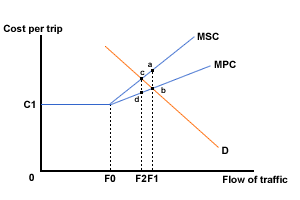The economic theory of traffic congestion
| Danger!!! This involves thinking In this market we are only considering the decision whether or not to take a car trip (ie NOT the production and consumption of cars or just petrol). Therefore the axes need labelling accordingly. |
Figure 1 below shows how the analysis of externalities that we looked at in the previous section can be applied to the problems of traffic congestion.

Figure 1 Road transport, congestion and economic theory
Economic theory can be used to
analyse the issues involved in traffic congestion as shown here. Figure
1 indicates the relationship between the cost of each car journey and
the flow of traffic along a particular route (Marginal in Sao Paulo).
When deciding to make a
journey by car, a motorist only considers the marginal private cost
(MPC) at C1. This is the cost directly attributable to him/herself,
such as time, fuel and the maintenance of the vehicle and it is
constant up to F0 number of cars, when the road begind to become
congested. However, the full cost of the journey, may include external
costs such as pollution, noise and time lost due to congestion and
these begin to bite at F0.
 For simplicity assume that congestion is the only cause of externalites.
For simplicity assume that congestion is the only cause of externalites.
The graph (Figure 1)
represents the Marginal Benefit (demand) for travel along a particular
stretch of road (For example The Marginal in Sao Paulo) over a period
of time. Up to a certain flow of traffic F0, there is no congestion
(think early Sunday morning), thus there is no divergence between MPC
and MSC, although in reality, such a situation only applies to
extremely low volumes of traffic.
As the flow of traffic increases above F0, congestion is apparent and there is a divergence between MSC and MPC. Note that the MSC is equal to the MPC, plus the external cost of congestion.
If the demand for travel on this particular route is of the normal shape (represented by D on the graph) and is a measure of the marginal benefit, then the flow of traffic will be determined by the intersection of the demand curve and the MPC curve at F1 and the private cost to the motorist will be b (but on the axis remember). At a flow of F1, the external cost, not taken into account by the drivers, is ab (the difference between the MPC and MSC). This means that resources are not being allocated efficiently and that more individuals are making journeys than they would if they were aware of the full social costs.
Since more drivers are using the road than the Social Optimum there is greater traffic congestion than there would be if drivers considered the full cost to society of each trip. Armed with this analysis perhaps you can begin to suggest ways to reduce traffic congestion on the marginal? What is already in place? Is it successful?
